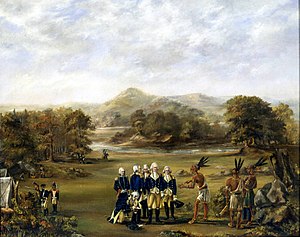Northwest Indian War
| Northwest Indian War | |||||||
|---|---|---|---|---|---|---|---|
| Part of the American Indian Wars | |||||||
 This depiction of the Treaty of Greenville negotiations may have been painted by one of Anthony Wayne's officers. |
|||||||
|
|||||||
| Belligerents | |||||||
|
Chickasaw Choctaw |
|||||||
| Commanders and leaders | |||||||
|
|
Blue Jacket Little Turtle Buckongahelas Egushawa |
||||||
| Strength | |||||||
| 4,000 colonial militiamen | 2,000 British soldiers 10,000 Native American warriors | ||||||
| Casualties and losses | |||||||
| 1,221 killed 458 wounded |
1,000+ killed Unknown wounded |
||||||
United States victory
Western Confederacy![]() Great Britain
Great Britain
The Northwest Indian War (1785–1795) also, known as the Ohio War, Little Turtle's War, and by other names, was a war between the United States and a confederation of numerous Native American tribes, with support from the British, for control of the Northwest Territory. It followed centuries of conflict over this territory, first among Native American tribes, and then with the added shifting alliances among the tribes and the European powers of France and Great Britain, and their colonials.
Under the Treaty of Paris (1783), which ended the American Revolutionary War, Great Britain ceded to the U.S. "control" of the Northwest Territory, which was occupied by numerous Native American peoples. Despite the treaty, the British kept forts there and continued policies that supported the Native Americans in the Northwest Territories. In 1787, there were 45,000 Native Americans in the territory, and 2,000 French. President George Washington directed the United States Army to enforce U.S. sovereignty over the territory. The U.S. Army, consisting of mostly untrained recruits supported by equally untrained militiamen, suffered a series of major defeats, including the Harmar Campaign (1790) and St. Clair's Defeat (1791), which were resounding Native American victories. About 1,000 soldiers and militiamen were killed and the United States forces suffered many more casualties than their opponents.
...
Wikipedia
